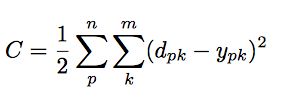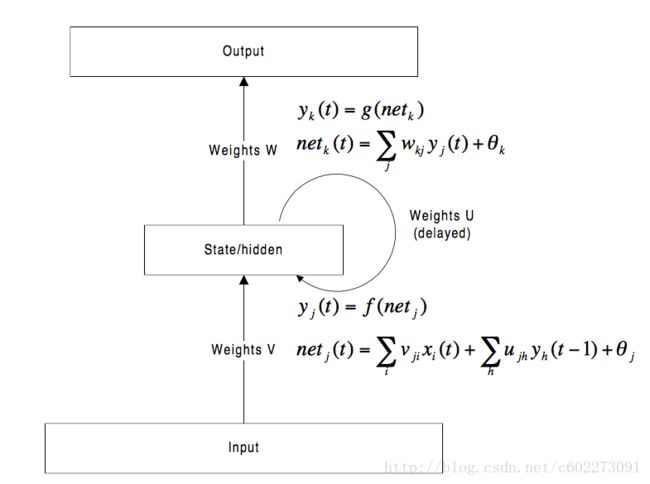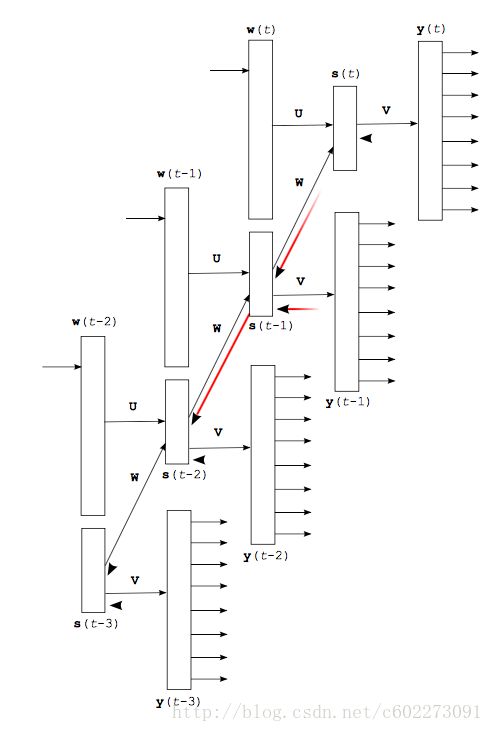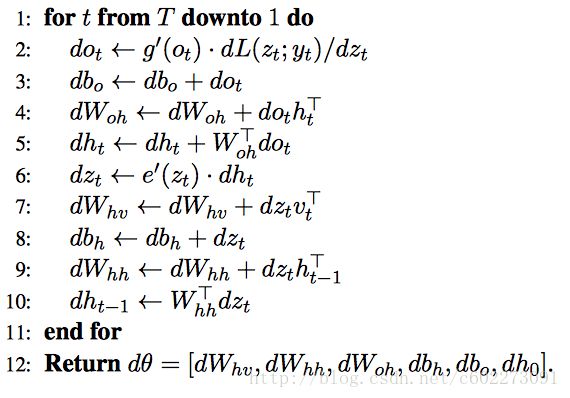Torch中的RNN底层代码实现
- 理论篇
- 代码篇
Torch中的RNN【1】这个package包括了RNN,RL,通过这个package可以很容易构建RNN,RL的模型。
安装:
luarocks install torch
luarocks install nn
luarocks install torchx
luarocks install dataload
如果有CUDA:
luarocks install cutorch
luarocks install cunn
记得安装:
luarocks install rnn但是如果要使用nn.Reccurent,需要安装:【4】
理论篇
这一次主要是讲最简单的RNN,也就是Simple RNN。实现的话是根据这两篇论文:【6】,【7】
首先介绍一下Simple RNN的整个网络结构,再说一下 ρ step 的BPTT。
整个网络可以用下图来表示:(这种网络的输入一部分是当前的输入,另外一部分来自于hidden layer的上一个输出,这种叫做Elman Network。另外一种网络是一部分来自于当前输入,另外一部分来自于整个网络的上一个输出)

- 当前输入 wt 与上一个hidden layer的输出 st−1 两个vector相加,得到真正输入到网络里面的东西。

- 接着是把输入送进一个logistic regression里面,得到hidden layer: st . st 一方面往输出那条路径走,另外一方面往缓存或者叫做Context里面存起来,称为下一个输入需要的一部分,替换 st−1 。


- 由 st 输出该时刻的output: yt 一个Linear加上softmax,非常简单。


这样呢就把整个网络结构描述完了,接下来就是如何训练得到参数了。(其实RNN,LSTM还有很多小的trick,同样的算法,trick不一样,结果都会千差万别)
了解了整个网络的以后,需要定义loss,在进行BP的时候,首先定义loss function,一般采用的是SSE: dpk 就是第p个sample,输出的feature第k个的label。 y 是prediction。

再进一步输出output的linear regression部分的w进行求导:

对hidden layer的输入的input部分参数进行求导:

对hidden layer的上一个hidden layer的作为input的部分进行求导:

目前的loss为SSE的时候,一般采用logistic function作为输出的函数:

![]()
当然,也可以有别的loss function,对应的output function g也会做乡相应改变。
使用cross-entropy作为loss:(g为logistic function)


对于分类问题,采用multinomial dostribution:
采用的是softmax作为g,然后loss function为:

在RNN中经常听到BPTT,就是让RNN在进行后向传递的时候不仅仅是当前这个时期,还有的是更多时刻:τ。
比如τ = 3,展开的图如下:展开了三次,那么进行BP的时候,就把各个参数往后相乘来更新w,这里需要注意vanishing gradient effect和explode gradient effect的东西,一个梯度衰减比如为0,一个梯度爆炸。

代码篇
这次描述的是Simple RNN,函数为nn.Recurrent 。在nn中有两个抽象类,一个是nn,用来构建网络,一个是Criterion【3】,用来提供比如cross entropy,reward。具体介绍可以看【2】,还有对应的论文。
在【3】中提出了一个简单的例子:目前下面的nn.Recurrent已经不在Torch的库中,所以要使用的话,就去安装这个人写的【4】
这里面的实现的RNN是最简单的,连hidden layer都没有,直接transfer就是输出了。
nn.Recurrent(start, input, feedback, [transfer, rho, merge])
-- start:对初始t=0的input进行处理
-- input:对t~=0的时候input进行处理
-- feedback:对s(t)进行处理缓存到了s(t-1)
-- transfer:对输出进行处理的函数
-- rho:进行BPTT的steps的数目
-- merge:对input x(t)和上一个时刻的输出s(t-1)进行融合-- generate some dummy inputs and gradOutputs sequences
-- 生成dummy input
inputs, gradOutputs = {}, {}
for step=1,rho do
inputs[step] = torch.randn(batchSize,inputSize)
gradOutputs[step] = torch.randn(batchSize,inputSize)
end
-- 调用RNN
-- an AbstractRecurrent instance
rnn = nn.Recurrent(
hiddenSize, -- size of the input layer(隐层的size)
nn.Linear(inputSize,outputSize), -- input layer(输入层进行linear regression)
nn.Linear(outputSize, outputSize), -- recurrent layer 输出层的linear regression
nn.Sigmoid(), -- transfer function,把输入通过linear regression之后的结果送到这个函数得到s(t),这个函数也可以改成ReLU别的激活函数
rho -- maximum number of time-steps for BPTT,进行BPTT时候的steps
)
-- feed-forward and backpropagate through time like this :
for step=1,rho
do
rnn:forward(inputs[step])
rnn:backward(inputs[step], gradOutputs[step])
end
rnn:backwardThroughTime() -- call backward on the internal modules
gradInputs = rnn.gradInputs
rnn:updateParameters(0.1)
rnn:forget() -- resets the time-step counter对完整的nn.Reccurent的理解:【10】
assert(not nn.Recurrent, "update nnx package : luarocks install nnx")
local Recurrent, parent = torch.class('nn.Recurrent', 'nn.AbstractRecurrent')
-- 把各个module放到RNN的对应位置
-- start是对最开始t=0输入inut做的处理
-- input是对t~=0的时刻进行input的处理
-- feedback是对s(t)进行处理缓存到s(t-1)的函数
-- transfer是对最后的输出的activation function
-- rho:是进行BPTT的时间
-- merge:对于输入x(t)和上一个时刻的hidden layer的输出s(t-1)的融合方法
function Recurrent:__init(start, input, feedback, transfer, rho, merge)
parent.__init(self, rho)
local ts = torch.type(start)
if ts == 'torch.LongStorage' or ts == 'number' then
start = nn.Add(start)
elseif ts == 'table' then
start = nn.Add(torch.LongStorage(start))
elseif not torch.isTypeOf(start, 'nn.Module') then
error"Recurrent : expecting arg 1 of type nn.Module, torch.LongStorage, number or table"
end
self.startModule = start
self.inputModule = input
self.feedbackModule = feedback
self.transferModule = transfer or nn.Sigmoid()
self.mergeModule = merge or nn.CAddTable()
self.modules = {self.startModule, self.inputModule, self.feedbackModule, self.transferModule, self.mergeModule}
self:buildInitialModule()
self:buildRecurrentModule()
self.sharedClones[2] = self.recurrentModule
end
-- 对最开始t=0的时候构建模型
-- build module used for the first step (steps == 1)
function Recurrent:buildInitialModule()
self.initialModule = nn.Sequential()
self.initialModule:add(self.inputModule:sharedClone())
self.initialModule:add(self.startModule)
self.initialModule:add(self.transferModule:sharedClone())
end
-- build module used for the other steps (steps > 1)
-- 构建整个模型
function Recurrent:buildRecurrentModule()
local parallelModule = nn.ParallelTable()
parallelModule:add(self.inputModule)
parallelModule:add(self.feedbackModule)
self.recurrentModule = nn.Sequential()
self.recurrentModule:add(parallelModule)
self.recurrentModule:add(self.mergeModule)
self.recurrentModule:add(self.transferModule)
end
-- 更新输出
function Recurrent:updateOutput(input)
-- output(t) = transfer(feedback(output_(t-1)) + input(input_(t)))
local output
if self.step == 1 then
output = self.initialModule:updateOutput(input)
else
if self.train ~= false then
-- set/save the output states
self:recycle()
local recurrentModule = self:getStepModule(self.step)
-- self.output is the previous output of this module
output = recurrentModule:updateOutput{input, self.outputs[self.step-1]}
else
-- self.output is the previous output of this module
output = self.recurrentModule:updateOutput{input, self.outputs[self.step-1]}
end
end
self.outputs[self.step] = output
self.output = output
self.step = self.step + 1
self.gradPrevOutput = nil
self.updateGradInputStep = nil
self.accGradParametersStep = nil
return self.output
end
-- 求解梯度,没有累加
function Recurrent:_updateGradInput(input, gradOutput)
assert(self.step > 1, "expecting at least one updateOutput")
local step = self.updateGradInputStep - 1
local gradInput
if self.gradPrevOutput then
self._gradOutputs[step] = nn.rnn.recursiveCopy(self._gradOutputs[step], self.gradPrevOutput)
nn.rnn.recursiveAdd(self._gradOutputs[step], gradOutput)
gradOutput = self._gradOutputs[step]
end
local output = self.outputs[step-1]
if step > 1 then
local recurrentModule = self:getStepModule(step)
gradInput, self.gradPrevOutput = unpack(recurrentModule:updateGradInput({input, output}, gradOutput))
elseif step == 1 then
gradInput = self.initialModule:updateGradInput(input, gradOutput)
else
error"non-positive time-step"
end
return gradInput
end
-- 求解梯度,但是会把t steps的梯度相加
function Recurrent:_accGradParameters(input, gradOutput, scale)
local step = self.accGradParametersStep - 1
local gradOutput = (step == self.step-1) and gradOutput or self._gradOutputs[step]
local output = self.outputs[step-1]
if step > 1 then
local recurrentModule = self:getStepModule(step)
recurrentModule:accGradParameters({input, output}, gradOutput, scale)
elseif step == 1 then
self.initialModule:accGradParameters(input, gradOutput, scale)
else
error"non-positive time-step"
end
end
function Recurrent:recycle()
return parent.recycle(self, 1)
end
function Recurrent:forget()
return parent.forget(self, 1)
end
function Recurrent:includingSharedClones(f)
local modules = self.modules
self.modules = {}
local sharedClones = self.sharedClones
self.sharedClones = nil
local initModule = self.initialModule
self.initialModule = nil
for i,modules in ipairs{modules, sharedClones, {initModule}} do
for j, module in pairs(modules) do
table.insert(self.modules, module)
end
end
local r = f()
self.modules = modules
self.sharedClones = sharedClones
self.initialModule = initModule
return r
end
function Recurrent:reinforce(reward)
if torch.type(reward) == 'table' then
-- multiple rewards, one per time-step
local rewards = reward
for step, reward in ipairs(rewards) do
if step == 1 then
self.initialModule:reinforce(reward)
else
local sm = self:getStepModule(step)
sm:reinforce(reward)
end
end
else
-- one reward broadcast to all time-steps
return self:includingSharedClones(function()
return parent.reinforce(self, reward)
end)
end
end
function Recurrent:maskZero()
error("Recurrent doesn't support maskZero as it uses a different "..
"module for the first time-step. Use nn.Recurrence instead.")
end
function Recurrent:trimZero()
error("Recurrent doesn't support trimZero as it uses a different "..
"module for the first time-step. Use nn.Recurrence instead.")
end
-- 把模型打印出来
-- 比如我调用的是:
-- nn.Recurrent(256, nn.Identity(), nn.Linear(256, 256), nn['ReLU'](), 99999)
-- [[[
{input(t), output(t-1)} -> (1) -> (2) -> (3) -> output(t)]
(1): {
input(t)
|`-> (t==0): nn.Add
|`-> (t~=0): nn.Identity
output(t-1)
|`-> nn.Linear(256 -> 256)
}
(2): nn.CAddTable
(3): nn.ReLU
}
---]]
function Recurrent:__tostring__()
local tab = ' '
local line = '\n'
local next = ' -> '
local str = torch.type(self)
str = str .. ' {' .. line .. tab .. '[{input(t), output(t-1)}'
for i=1,3 do
str = str .. next .. '(' .. i .. ')'
end
str = str .. next .. 'output(t)]'
local tab = ' '
local line = '\n '
local next = ' |`-> '
local ext = ' | '
local last = ' ... -> '
str = str .. line .. '(1): ' .. ' {' .. line .. tab .. 'input(t)'
str = str .. line .. tab .. next .. '(t==0): ' .. tostring(self.startModule):gsub('\n', '\n' .. tab .. ext)
str = str .. line .. tab .. next .. '(t~=0): ' .. tostring(self.inputModule):gsub('\n', '\n' .. tab .. ext)
str = str .. line .. tab .. 'output(t-1)'
str = str .. line .. tab .. next .. tostring(self.feedbackModule):gsub('\n', line .. tab .. ext)
str = str .. line .. "}"
local tab = ' '
local line = '\n'
local next = ' -> '
str = str .. line .. tab .. '(' .. 2 .. '): ' .. tostring(self.mergeModule):gsub(line, line .. tab)
str = str .. line .. tab .. '(' .. 3 .. '): ' .. tostring(self.transferModule):gsub(line, line .. tab)
str = str .. line .. '}'
return str
end转载请注明出处: http://blog.csdn.net/c602273091/article/details/78975636
参考链接:
【1】RNN地址: https://github.com/torch/rnn
【2】nn Package: https://arxiv.org/pdf/1511.07889.pdf
【3】RNN Code: https://github.com/torch/rnn/blob/master/doc/recurrent.md#rnn.Recurrence
【4】nn.Reccurent: https://github.com/Element-Research/rnn/blob/master/Recurrent.lua
【5】nn RNN: https://github.com/Element-Research/rnn
【6】Recurrent neural network based language model: http://www.fit.vutbr.cz/research/groups/speech/publi/2010/mikolov_interspeech2010_IS100722.pdf
【7】 A guide to recurrent neural networks and backpropagation: http://citeseerx.ist.psu.edu/viewdoc/download;jsessionid=CDD081815C5FAC4835EF27B81EEA5F8C?doi=10.1.1.3.9311&rep=rep1&type=pdf
【8】STATISTICAL LANGUAGE MODELS BASED ON NEURAL NETWORKS: (3.2~3.3)http://www.fit.vutbr.cz/%7Eimikolov/rnnlm/thesis.pdf
【9】TRAINING RECURRENT NEURAL NETWORKS:(2.5~2.8) http://www.cs.utoronto.ca/%7Eilya/pubs/ilya_sutskever_phd_thesis.pdf
【10】nn.Reccurent: https://github.com/Element-Research/rnn/blob/master/Recurrent.lua










